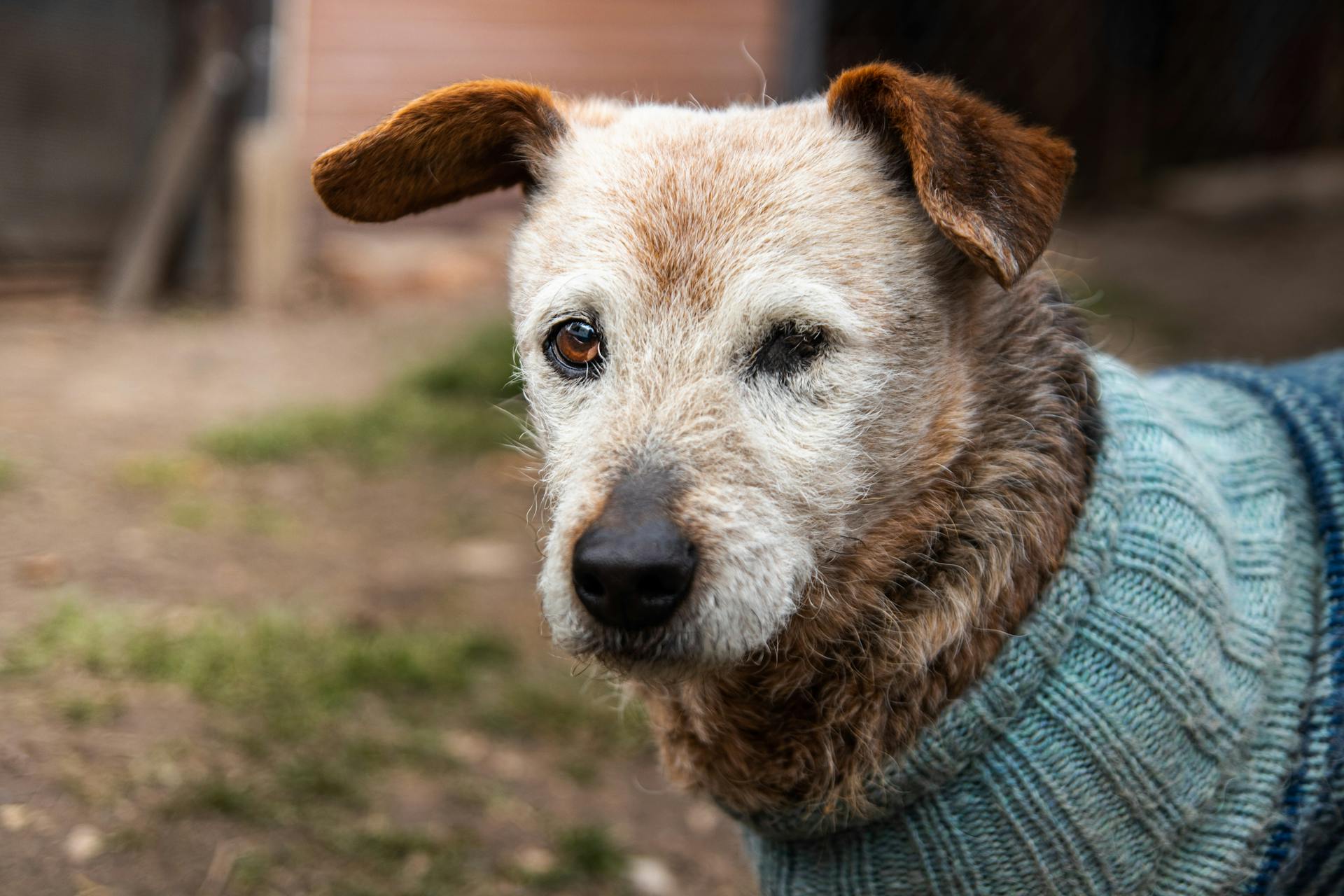
Ear cropping, a common practice in some breeds, can be a significant decision for pet owners. The ideal age for ear cropping varies depending on the breed and purpose.
For puppies, ear cropping typically occurs between 6 to 12 weeks old, depending on the breed standard.
Most veterinarians agree that ear cropping is most effective when done before the puppy's ears start to fold over, usually around 8 weeks old.
Ear cropping can be performed on adult dogs, but it's generally more challenging and may require additional anesthesia.
History and Purpose
Ear cropping has a long history that dates back to ancient times. Many cultures believed that ear cropping was a sign of status or nobility.
In some breeds, ear cropping is still a common practice today. This is often done for health and hygiene reasons, as well as to maintain a breed's appearance.
The American Veterinary Medical Association (AVMA) has taken a stance on ear cropping, stating that it is a surgical procedure that should only be performed for medical reasons.
Why Do People Crop Dogs' Ears?
People crop the ears of certain breeds of dogs to meet a cosmetic appearance, sometimes to honor or replicate a putative function.
Historically, breeds developed to be barn ratters, such as the Miniature Pinscher and Brussels Griffon, had their ears cropped to minimize the risk of injury to the ear pinna.
Some breeders continue to crop the ears of these breeds to maintain the look related to their historic function, even though they're no longer used as barn ratters.
The "bully breeds" were once used for dog fighting, and their ears were severely cropped to prevent an opponent from gaining an advantage.
That closely cropped look has become synonymous with toughness, an attribute admired by fans of those breeds.
There is no evidence that ear cropping enhances a dog's hearing, and in fact, it may decrease their hearing acuity.
Check this out: Doberman Pinscher Short Crop
Age and Timing
The ideal age for ear cropping in Doberman Pinschers is a crucial consideration. It's generally recommended to crop a Doberman's ears between 7-9 weeks of age.
If the ears are cropped too early, at 6 weeks or younger, it can be difficult for the veterinarian to determine the future proportions of the ear, leading to unusual looking ears when the dog is older. On the other hand, if the ears are cropped too late, at 12 weeks or older, the cartilage in the ear has already hardened into a flat shape, making it impossible for it to harden into a more rounded, vertical standing manner.
Here are the specific age ranges to keep in mind:
- Ear cropping can be done as early as 6 weeks of age, but this is not ideal.
- The ideal age for ear cropping is 7-9 weeks of age.
- Ear cropping can be done as late as 12 weeks of age, but this may lead to increased discomfort and less desirable results.
Why the Time Limit?
The time limit for ear cropping in Doberman Pinschers is crucial for a successful procedure. There are a few reasons for this.
If the ears are cropped too young, it's difficult for the veterinarian to determine the future proportions of the ear, which can lead to unusual looking ears when the dog is older. The youngest a Doberman can be at the time of ear cropping is 6 weeks of age.

If the ears are cropped too old, the cartilage in the ear has already hardened into a flat shape, making it impossible for it to harden into a more rounded, vertical standing manner. The oldest a Doberman can be at the time of ear cropping is generally considered to be about 12 weeks of age.
The ideal age for a Doberman to get their ears cropped is generally between 7-9 weeks of age.
Here are the age ranges to keep in mind:
- 6 weeks: The youngest a Doberman can be at the time of ear cropping.
- 7-9 weeks: The ideal age for a Doberman to get their ears cropped.
- 12 weeks: The oldest a Doberman can be at the time of ear cropping.
Older Doberman's
Older Doberman's have a unique situation when it comes to ear cropping. Generally, cropping a Doberman's ears after 12 weeks old is not successful.
However, some older Doberman's have had their ears successfully cropped due to unusually thin or flexible ear cartilage.
A physical examination by the vet is necessary to determine if an older Doberman can have its ears cropped.
If the owner desires a shorter ear crop, it's more likely to be successful at an older age. This is because the longer the ears are, the more difficult it is to get them to stand.
Some veterinarians will agree to crop older Doberman's even after their ear cartilage has hardened. They compensate for the hardened ear cartilage by inserting an implant into the ears to make them stand up.
You might like: When Is It Too Late to Crop a Dog's Ears?
Results
At 8 to 12 weeks old, most veterinarians recommend spaying or neutering dogs to prevent unwanted breeding and reduce the risk of certain health issues. This age range is ideal for surgery because puppies are typically weaned and have reached a safe weight.
Puppies can be spayed or neutered as early as 6 weeks old, but some veterinarians may recommend waiting until they are a bit older. This decision ultimately depends on the individual puppy's size, health, and breed.
Spaying or neutering too early can increase the risk of certain health problems, such as joint issues and obesity, in large breed dogs.
Explore further: Puppies Eat Rabbit Ears
What's in Dogs?
Ear cropping is a surgical procedure that's usually performed on puppies between 6–12 weeks old.
This age range allows for further development of the ear after surgery, and it's also believed that older animals suffer more from the pain of the procedure.
Most ear cropping is performed to achieve a specific appearance, and it's extremely uncommon in mixed-breed dogs.
Common breeds that exhibit cropped ears include Doberman Pinschers, Great Danes, Mastiffs, and Pit Bull Terriers.
These breeds often have their ears cropped to a specific shape or size, with some having very little of their outer ear left.
The extent of the procedure can vary, but it's always performed by a licensed veterinarian under general anesthesia.
In some cases, the remaining tissue is positioned with tape and bandages to encourage the appearance of a pointed ear.
Here are some common breeds that have their ears cropped:
- Doberman Pinschers
- Great Danes
- Mastiffs
- Pit Bull Terriers
Frequently Asked Questions
Can you crop ears at 14 weeks?
Ear cropping is typically recommended for puppies between 11 and 15 weeks old, but consult with a veterinarian for breed-specific guidance. If your puppy is 14 weeks old, it's likely within the ideal age range for ear cropping.
Can you crop a pitbull's ears at 1 year?
Yes, a vet can crop a Pitbull's ears at 1 year of age, but it requires a skilled vet and proper ear development for the best results. Consult a veterinarian to determine if your Pitbull is a good candidate for ear cropping.
Sources
- https://spcanevada.org/services/pet-education/animal-ally/tail-docking-and-ear-cropping-what-you-should-know/
- https://www.petmd.com/dog/general-health/ear-cropping-dogs
- https://www.ncbi.nlm.nih.gov/pmc/articles/PMC4922641/
- https://www.whole-dog-journal.com/health/ear-cropping/
- https://www.dobermanplanet.com/what-age-can-you-crop-a-dobermans-ears/
Featured Images: pexels.com


